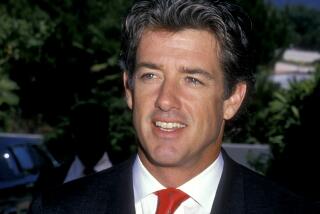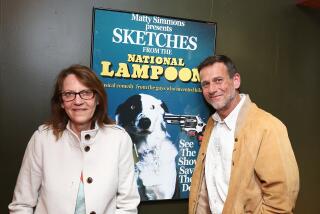From the Archives: Movie and TV Actor Fred MacMurray Dies
Fred MacMurray, the dapper and durable leading man in a series of fast-paced film comedies in the 1930s and ‘40s whose career was given a latent boost as the father of “My Three Sons” and as a whimsical professor in Walt Disney pictures, died Tuesday.
He was 83, said Warren Cowan, the public relations executive who represented him for many years, and he died of pneumonia after a lengthy battle with cancer.
At his bedside when he died at St. John’s Hospital and Health Center in Santa Monica, Cowan said, were his wife of 37 years, the former actress June Haver, and a daughter, Kate. Daughters Laurie and Susan and a son, Robert, also survive, as do seven grandchildren and one great-grandchild.
A master of comedic timing, MacMurray was one of those rare actors equally at home in drama.
In one of his most acclaimed performances, he portrayed a crooked insurance agent in the 1944 picture “Double Indemnity” in which he schemed with a sultry Barbara Stanwyck to do away with her husband. In a completely opposite but equally well-received role in 1960 he was a philandering business executive in “The Apartment.” There he regularly took the keys to an acquiescing Jack Lemmon’s domicile where he held a series of illicit rendezvous.
But generally he was, as director Billy Wilder once said, “everybody’s nice fellow.”
“Sometimes,” MacMurray told the Saturday Evening Post many years ago, “a writer writes scenes for people who just say ‘hi’ to indicate they’re in love. I play those scenes very well.”
What he was, basically, he told interviewers over the years, was “a personality not an actor” who stumbled into films by accident.
What he didn’t tell interviewers was that he also was one of the wealthiest stars to ever emerge from the fickle world of film.
His portrayals of befuddled nice guys or good fellas gone astray brought him a series of paychecks unrivaled in size for their day. He invested a great many of those checks in property, office buildings and income units at prewar prices and watched quietly as his holdings grew through the postwar and subsequent land booms.
Frederick Martin MacMurray was born in Kankakee, Ill., where his violinist father happened to be giving a concert at the time. And although he first gravitated to show business as a saxophonist, it was as a violinist that he made his first public appearance. He was 5 years old and standing on a chair trying to approximate his father’s height as MacMurray pere played alongside him.
The stage fright that set in that day never left him, he would say later, and although he did eventually grow more comfortable in front of movie and TV cameras, he never found that same comfort before people. Those who knew him say the bewilderment he reflected on screen probably was a natural outgrowth of innate shyness.
MacMurray was a star athlete and scholar at high school in Beaver Dam, Wis., where he played baritone saxophone, first with the American Legion Band and then with his own three-piece group, Mac’s Melody Boys, in which he not only played solos but sang.
With the help of an American Legion scholarship he enrolled in Carroll College in Waukesha, Wis., to study music and from there went to Chicago where he studied at night at the Chicago Art Institute, supplementing his in-come by playing with a dance band.
Then his mother decided to take a trip to Los Angeles. And her son was the designated driver.
When MacMurray next saw the Midwest he had become a successful film star.
In Los Angeles he had found work as a movie extra and in an assortment of orchestras, and in 1929 was hired by the California Collegians, one of the first bands to play in vaudeville. He and the Collegians moved to New York to make their stage debut in the 1930 Broadway comedy “Three’s a Crowd,” which featured Fred Allen and Clifton Webb. MacMurray, independently, was chosen as Bob Hope’s understudy in the Broadway musical “Roberta.”
While in “Roberta” he met dancer Lillian Lamont, whom he married in 1936. After her death in 1953 he married Miss Haver.
A Paramount Pictures agent saw him and arranged a screen test, which led to a contract. MacMurray returned to Los Angeles, making his film debut in “Tiger Rose” in 1930 and then landing a featured role in “Grand Old Girl” in 1935. But it was “The Gilded Lily” opposite Claudette Colbert in 1935 that proved his step to stardom.
In it he played a poor but honest American working stiff with the endearing qualities that became the MacMurray persona for the next 40 years. And of course he got the girl.
In the next five years he was seen in “The Bride Comes Home,” a romantic comedy; “Alice Adams,” a melodrama; “True Confession,” a murder-oriented farce; and “Cafe Society,” a long forgotten tale of a socialite who loves an annoying news reporter.
MacMurray was developing the reputation that was to follow him throughout his professional life. As Wilder, his director in “Double Indemnity” and “The Apartment,” observed: “Fred MacMurray . . . gives people the feeling that he’s kind to dogs, children, mothers and widows.”
He made two-thirds of the approximately 90 films that became his celluloid legacy between 1940 and 1978 and many of them were praised for their content as well as MacMurray’s generally understated performances. He appeared opposite the top leading ladies of Hollywood’s putative Golden Age—Marlene Dietrich, Miss Stanwyck and Madeleine Carroll.
He flirted briefly with drama in the ‘40s and ‘50s (“Double Indemnity,” “The Caine Mutiny,” “Rains of Ranchipur”) but then left both comedy and drama behind to become a minor star of Westerns (“Callaway Went Thataway,” “At Gunpoint,” “Gun for a Coward,” etc.).
By the late 1950s his career had settled into a comfortable routine even though the pace of his work had slackened. Then Walt Disney came to him with a proposal to return to comedy; this time in a movie about a boy who not only turns into a dog but manages to apprehend criminals. “The Shaggy Dog” was the first in a lengthy relationship with the Disney studios that also produced “The Absent-Minded Professor” who invents a miracle flying rubber substance he dubs “flubber.” It was a far cry from plotting the demise of Stanwyck’s husband in that apex of film noir “Double Indemnity” but it led to such further Disney mischief as “Bon Voyage,” “Son of Flubber,” “Follow Me Boys” and “The Happiest Millionaire,” which one reviewer called “a contender for the worst Hollywood film of the year” (1967).
Fortunately a new generation would have something else to remember when it came to Fred MacMurray.
The square-jawed, 6-foot, 200-pound actor had dabbled in radio in the 1940s; his 17 appearances on the old “Lux Radio Theatre” were exceeded only by Don Ameche’s 18. But it was radio’s offspring, television, that was to display the MacMurray charms anew.
“My Three Sons” went on the air Sept. 29, 1960, and quickly was woven into the American social fabric where it remained for the next 12 years.
MacMurray portrayed Steve Douglas, a consulting engineer and a widower faced with raising three boys who continually trailed laughter and tears in their wake. When MacMurray wasn’t solving Solomon-like the dilemmas of his sons he was fending off the advances of attractive women out to marry him. For a time William Frawley as Steve’s father-in-law helped with the housework but after illness forced him off the air (he died in 1966) William Demarest as Uncle Charley became the family friend and foil.
By the time the series ended in 1972, MacMurray had seen his TV sons happily married and producing children of their own. The series proved so popular that in its final months reruns were being shown during the day while new episodes were being screened in prime time.
MacMurray had not been anxious at first to commit himself to a regular series and a grueling shooting schedule. But by the time producer Don Fedderson had offered him a partnership and a schedule in which MacMurray’s scenes would be filmed within a 13-week period, MacMurray agreed to periodically abandon his golf clubs, fishing pole and Northern California cattle ranch.
At home he dabbled in watercolors and drew the praise of friends for his devotion to his family.
In one of only a handful of interviews that the modest actor ever granted over the years, he said he was mystified when he saw some of the comments of his colleagues:
“When I read some of the things other movie people say about their work, I think I’m in the wrong business. I don’t have any of those deep thoughts. I’m just myself—that’s what I’m hired for.”
In lieu of flowers the family is asking contributions to Childhelp U.S.A., an organization that helps battered children. Services will be private.
From the Archives: Actor Peter Sellers, Comic Film Genius, Dies at 54
From the Archives: Pioneering Photographer, Filmmaker Gordon Parks Dies
From the Archives: June Haver, 79; Movie Star Later Married Actor Fred MacMurray
From the Archives: Jack Lemmon, Everyman Star, Dies
From the Archives: Wizard of Fantasy Walt Disney Dies
More to Read
Start your day right
Sign up for Essential California for the L.A. Times biggest news, features and recommendations in your inbox six days a week.
You may occasionally receive promotional content from the Los Angeles Times.







